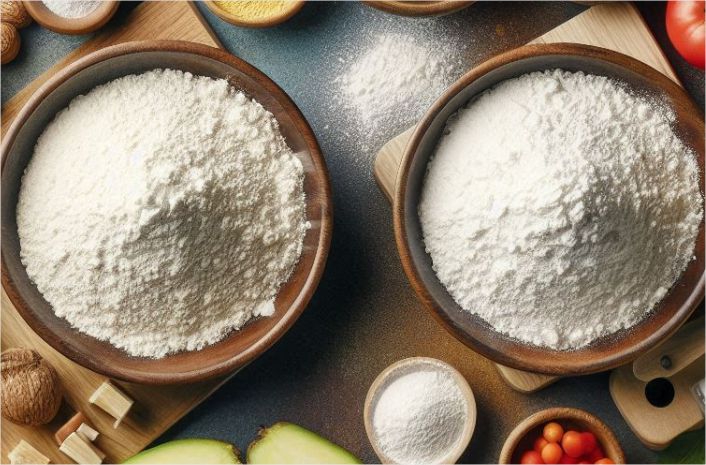Cassava Flour vs Regular Flour: Discover the key differences, benefits, and best uses to choose the right flour for your needs.
When choosing flour for baking and cooking, you have a variety of options, but cassava flour and regular flour stand out for their distinct properties.
Cassava flour, made from the whole cassava tuber, is naturally gluten-free and popular among those avoiding wheat-based products.
Regular flour, commonly derived from wheat, is a staple in traditional baking due to its gluten content, which provides elasticity and structure to dough.
Understanding the differences between cassava flour and regular flour can help you decide which one best fits your dietary needs and cooking preferences.
This article explores their nutritional profiles, culinary applications, taste, texture, and how they perform in different recipes.
Related: Comparing Cassava Flour and All-purpose Flour
An Overview of Cassava Flour and Regular Flour
Cassava flour is made from the cassava crop’s root, a starchy tuber grown in tropical regions. The process involves peeling, washing, drying, and grinding the root into a fine powder.
Unlike tapioca flour, which is pure starch, cassava flour retains the whole root, making it higher in fiber and nutrients.
Naturally gluten-free, it’s an excellent choice for those with gluten intolerance. With its mild, slightly nutty flavor, it works well in both sweet and savory dishes.
However, since it absorbs more liquid than wheat flour, recipe adjustments may be needed.
Regular flour, typically made from wheat, is a staple in baking. It comes in varieties like all-purpose, whole wheat, and bread flour, each with different protein levels.
Thanks to its gluten content, regular flour provides elasticity and chewiness in baked goods. Affordable and widely available, it’s perfect for making bread, pasta, cakes, and pastries, offering structure and a soft, airy texture.
Recommended: Cassava Flour vs Tapioca Flour
Cassava Flour vs Regular Flour: Nutritional Comparison
Understanding the nutritional differences can help you determine which flour fits your dietary goals.
Here is a tabulated nutritional comparison of both:
| Nutrient | Cassava Flour (per 100g) | Regular Flour (per 100g) |
|---|---|---|
| Calories | 330 kcal | 364 kcal |
| Carbohydrates | 78g | 76g |
| Protein | 2g | 10g |
| Fat | 0.6g | 1g |
| Fiber | 3.7g | 2.7g |
| Gluten | None | Present |
| Iron | 1.58mg | 1.2mg |
| Calcium | 33mg | 15mg |
Cassava flour has fewer proteins but provides more dietary fiber than refined wheat flour. This makes it suitable for gluten-free diets but less ideal for protein-rich recipes.
Regular flour offers a balanced macronutrient profile, making it a staple for high-protein baked goods.
Related: How is Coconut Flour Different from Cassava Flour?
Baking and Cooking Performance
Cassava flour and regular flour behave differently in recipes, affecting texture, consistency, and absorption.
| Feature | Cassava Flour | Regular Flour |
| Gluten Content | Gluten-free | Contains gluten |
| Texture | Light, slightly grainy | Smooth and elastic |
| Moisture Absorption | High | Moderate |
| Binding Ability | Requires additional binders | Naturally cohesive |
| Taste | Mild, slightly nutty | Neutral |
| Common Uses | Gluten-free baking, tortillas, sauces | Bread, cakes, pastries, pasta |
Since cassava flour lacks gluten, it does not provide the elasticity required for traditional bread making.
However, it works well in flatbreads, cookies, and cakes when combined with a binder like eggs or xanthan gum.
Regular flour, with its gluten structure, creates airy and chewy textures, making it irreplaceable in certain recipes like yeast bread and pasta.
Related: Almond Flour and Cassava Flour: Any Difference?
Substituting Cassava Flour for Regular Flour
If you want to replace regular flour with cassava flour, adjustments are necessary to maintain the texture and consistency of your recipe.
According to research on Maxwellsci, any flour for baking should contain at least 10 – 12% protein. Here are possible adjustments you can make to your flour:
Here we go:
- Use a 1:1 Ratio for Some Recipes: Cassava flour can replace wheat flour in simple recipes like pancakes and brownies.
- Adjust Liquid Content: Cassava flour absorbs more moisture, so you may need extra water, milk, or fat.
- Add a Binding Agent: Since cassava flour lacks gluten, ingredients like eggs, flaxseeds, or guar gum can help with structure.
- Combine with Other Flours: Mixing cassava flour with almond flour or coconut flour can enhance texture.
Further Reading: Cassava Flour vs Wheat Flour
Cost and Availability
Regular flour is widely available and budget-friendly, making it the go-to choice for most households.
Cassava flour, while growing in popularity, is more expensive due to its specialized processing and demand in gluten-free markets.
| Factor | Cassava Flour | Regular Flour |
| Price | More expensive | More affordable |
| Availability | Specialty stores, online | Grocery stores, supermarkets |
| Shelf Life | Longer if stored properly | Varies based on type |
If affordability is a priority, regular flour remains the better option. However, if you need a gluten-free alternative, cassava flour is a valuable investment.
Related: The Making of Cassava Flour
Which One Should You Choose?
Your choice depends on dietary preferences, health conditions, and cooking needs.
- Choose Cassava Flour if:
- You follow a gluten-free, paleo, or grain-free diet.
- You need an alternative to traditional wheat flour in baked goods.
- You prefer a mild flavor with added fiber benefits.
- Choose Regular Flour if:
- You need elasticity for bread, pasta, or pastries.
- You are looking for a cost-effective, widely available option.
- You want a high-protein flour for structured baking.
Conclusion
Both cassava flour and regular flour have unique properties that influence their use in cooking and baking. If you need a gluten-free alternative with high fiber, cassava flour is a great choice.
However, if you rely on traditional baking techniques and need the elasticity of gluten, regular flour remains irreplaceable.
Understanding their differences allows you to make informed decisions, ensuring the best results for your recipes.

Chimeremeze Emeh is a writer and researcher passionate about Africa’s most transformative root crop—cassava. Through his work at cassavavaluechain.com, he explores the entire cassava industry, from cultivation and processing to its diverse applications in food, health, and industrial use.
He also writes for palmoilpalm.com, where he shares his extensive experience and deep-rooted knowledge of palm oil, covering red palm oil, palm kernel oil, and refined products. His work there reflects his lifelong connection to agriculture and his commitment to promoting sustainable value chains in Africa.
Driven by curiosity and purpose, Chimeremeze aims to shed light on how cassava continues to empower communities, strengthen food systems, and link traditional farming wisdom with modern innovation.

